"Take One: Action!" - "Re-Moving Pictures" - "40th Anniversary Review"- "Old Dogs & New Tricks"
The story behind Moving Pictures, and Alex Lifeson's new solo project...
PROG #129, April 2022, transcribed by John Patuto
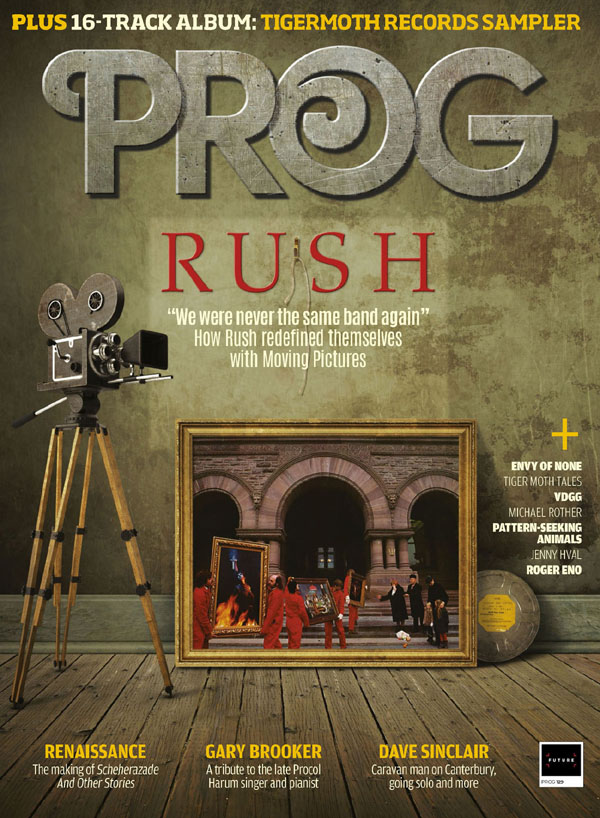
Take One: Action!
By Philip Wilding
It was the album that was never supposed to be, and now Rush's Moving Pictures has been given a 40th anniversary reissue. Geddy Lee and Alex Lifeson recall angry mobs, out-of-control aeroplanes and Superman in the story behind the hugely successful record that gave us Tom Sawyer and defined the sound of rock music in the early 80s.
It's quiet out here. Or it was. Canadian country singer Ronnie Hawkins' estate looks out on to Stoney Lake, a geographical idyll in Peterborough County in central Ontario. The surface of the lake is glassy and dark and so flat it looks like you could step out onto the water and walk to the furthest shore. The day's a liquid blue, the clouds like pale abstractions or opaque afterthoughts dotted towards the horizon.
The dark wooden barn sits back on the property, away from the main house with its bay window looking out towards the serrated edges of fir trees that sit jaggedly against the sky. The barn rattles and hums all hours of the day and sometimes night. The frenetic writing sessions taking place inside fizz and fade as the orange burns out of the August afternoons. Although the keening guitars, rumbling bass and impossible drum parts aren't the cause of consternation for the birds dotted among the woods this afternoon: it's the strange, relentless engine hum overhead, a daring blur of propeller blades and a small engine that sounds like it might choke, stutter and disappear out of sight at any moment.
"Oh," says Geddy Lee. "Alex [Lifeson] was in the heat of his 'model aeroplane period' at that point." He makes inverted commas in the air with both fingers, faux-exasperated eyebrows arching upwards. "Even Broon (producer Terry Brown) had the stupidest aeroplane you've ever seen in your life.
Lifeson: "I like to have a hobby when we're working."
Alex Lifeson is grinning like he's still got that model aeroplane tucked under one arm and is heading to a vantage point to send it into the sky.
"I had a radio-controlled plane that I built there and crashed into the top of a truck. Might have been Broon's truck? Bang, right into the top of the cab, put a hole in the roof," he recalls. "But you should have seen the plane that Terry had. It was on these lines, and you flew it in circles, I guess. And the engine on it was probably 12,000 horsepower, and it went, like, 900 miles an hour. But in a circle."
Lee: "It was going around and around, getting faster and faster and Terry was holding on to it and getting dizzier and dizzier..."
Lifeson: "And he had to let go of it. He was going around and around, and I was laughing so much that I had to lay down in the grass. There were literally tears in my eyes."
Lee: "I was standing not too far from him. And when the thing took off, I had to hit the deck! This plane whizzing around overhead tethered to Broon - I mean, it had to come down eventually. He could barely stay upright. It was great. They were fun writing sessions, a good head space."
Lifeson: "As long as you weren't being hit in the head, by, you know, Broon's or my plane..."
Welcome to the writing sessions for an album that would help define not only Rush, but also rock music in the early 80's: Moving Pictures.
It's early 2022 and Alex Lifeson and Geddy Lee are sat in their respective homes in Toronto, the town where they both met as gawky kids with ambitions of being in a band. Lee is in his living room, Lifeson in his home studio, the wall behind him hung with guitars. Even on a Zoom call, the sparky energy that kept them as friends and band mates for over 40 years is still self-evident. They are, at turns, reflective, forgetful, deeply focused or simply goofy when it comes to recalling the summer writing stints - and autumn and winter recording sessions - that led to them making a record that would help propel them to platinum rock star status, and go on to dominate their live set until the band finally retired in 2015.
It'll give readers some idea of the hectic writing, recording and touring schedule that the band were all undergoing at that point in their career that it was straight after they'd finished writing for Moving Pictures that they packed up their equipment, rescued Lifeson's plane from a tree and set out to play some shows before heading to Morin-Heights to begin making Moving Pictures.
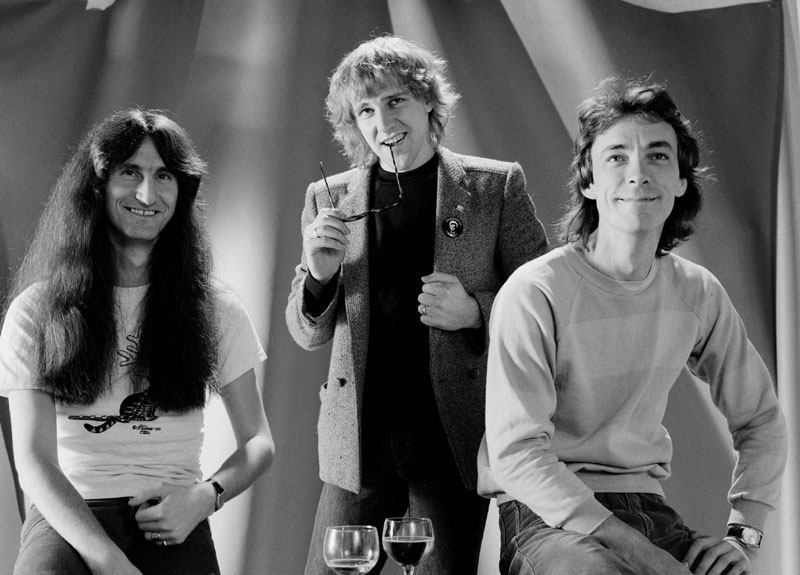
If you were lucky enough to see Rush play those dates in September 1980 - 16 scant shows - you'd have seen the trio showcase two brand-new songs too: Tom Sawyer and Limelight.
"We played them live on those shows?" asks Lifeson. "Did we?"
"To warm them up," says Lee.
Lifeson: "Then how come Tom Sawyer was the hardest song to capture in the studio?"
Welcome to Le Studio. Now synonymous with the Rush name, they'd go on to record seven albums there, starting with Permanent Waves in 1980 and ending with 1993's Counterparts. Set on Lake Perry and in the foothills of the spectacular Laurentian Mountains, you can see why a band might be drawn there, as Lee puts it: "It was truly a part of the great Canadian landscape."
"A magical place," remembers Lifeson, "but practical too; you could drive home within five hours. And the house and the view... We had a volleyball court outside - it was right on the lake. We had barbecues in the summer. Every time we went there, we went back to what we liked to think of as 'our rooms'. It had that warm familiarity."
"And before Le Studio," says Lee, "you have to remember that we had been recording in Europe before we went there to make Permanent Waves, and all of a sudden, we're in this really beautiful studio room and it has these giant picture windows and this insane view. The lake, the mountains and you're banging away at Freewill, or whatever it might be. Le Studio was a revelation in the way we worked as a band; it was such a charming spot."
And they even had their own French chef on site.
"That part of Quebec," says Lee with a smile, "is French and English, so you know... it's expected. And he was a very good chef."
Tonight, though, Le Studio is cold and dark, a place filled with foreboding. The lake is icy and the air frigid. The studio lights pick out the figures massed on the drive leading up to the main building, silhouettes wrapped in scarves and hats, their breath rising above them in hazy clouds. News of John Lennon's death that day has emanated from New York City. The band, who spent the autumn recording here, are back for overdubs and mixing, adding some elusive aural sparkle to the album. Sparkle that, for tonight at least, sees drummer Neil Peart rallying crew, studio staff and band members alike into what might pass for an angry mob as a precursor to the doomy intro for Witch Hunt (Part III Of Fear).
"We put microphones on the driveway," says Lee, "and we got bundled up and went outside. We all started grunting and shouting stupid shit. We overdubbed over the top of ourselves over and over again until we created a vigilante mob. If you listen really carefully, you can hear some of the stupid things we said..."
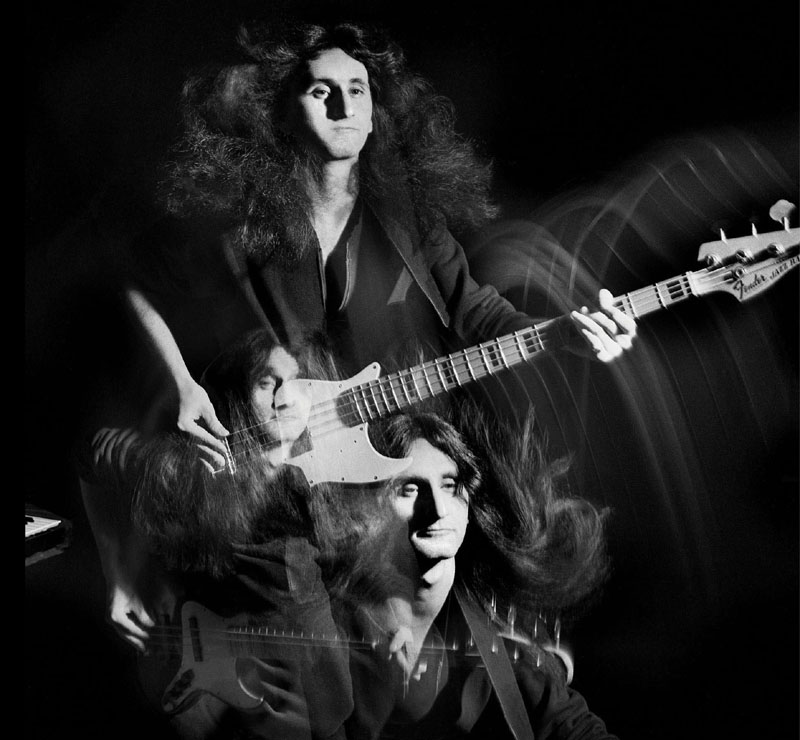
"And the laughing, which was probably not what Neil was going for," Lifeson adds. "We took a bottle of Scotch with us as well, which might explain the laughter."
Lee: "A lot of laughter. It was good fun getting to do that."
Lifeson: "Fucking football,' which I think you can still hear if you listen closely enough - that was my line, one of the many recurring highlights."
Though, as history bears out, that mob wasn't meant to be there that night. The band should have been home. There was no plan for an album called Moving Pictures and no new studio album in the pipeline after the surprise crossover success of Permanent Waves. The idea was another live album, another tour; maybe to think about the next studio record. But such was the band's momentum that they canned the idea of releasing a live album off the back of what had become their most successful tour and headed back into the Canadian countryside and to Le Studio.
"We were scheduled to do this big live album after Permanent Waves," says Lifeson. "And at the last minute we said, 'You know what? Fuck this, we're not going to do a live album. We're going to go back into the studio and do our next album.' And that's how Moving Pictures came to be. And it turned out to be the most important decision of our careers. Or the second most important decision, the first one being 2112, because without 2112, there would be no Rush."
"It was actually a friend of ours who worked for Mercury at the time, Cliff Burnstein," says Lee. "Cliff [who would go on to manage Metallica and Def Leppard as part of the Q Prime group] was responsible for getting us signed at Mercury. He was a huge fan of the first album. I remember we had played New York, and he came to the gig and we were talking about doing a live album. And he kind of said to us guys, 'You know, Permanent Waves was so great that maybe you should think about going straight back in the studio to do another record!'
"So we talked about it and thought, "That does sound more fun!' So that's what we did, but Cliff sort of planted the seed of us changing.
"And it was exciting to suddenly change plans. 'Okay, fuck it,' you know? 'We're going back in the studio!' And we were in a groove from Permanent Waves, we had kind of hit on a new style for ourselves; working in these shorter time frames, but still building these complexities within those time frames, and it was kind of an exciting period for us."
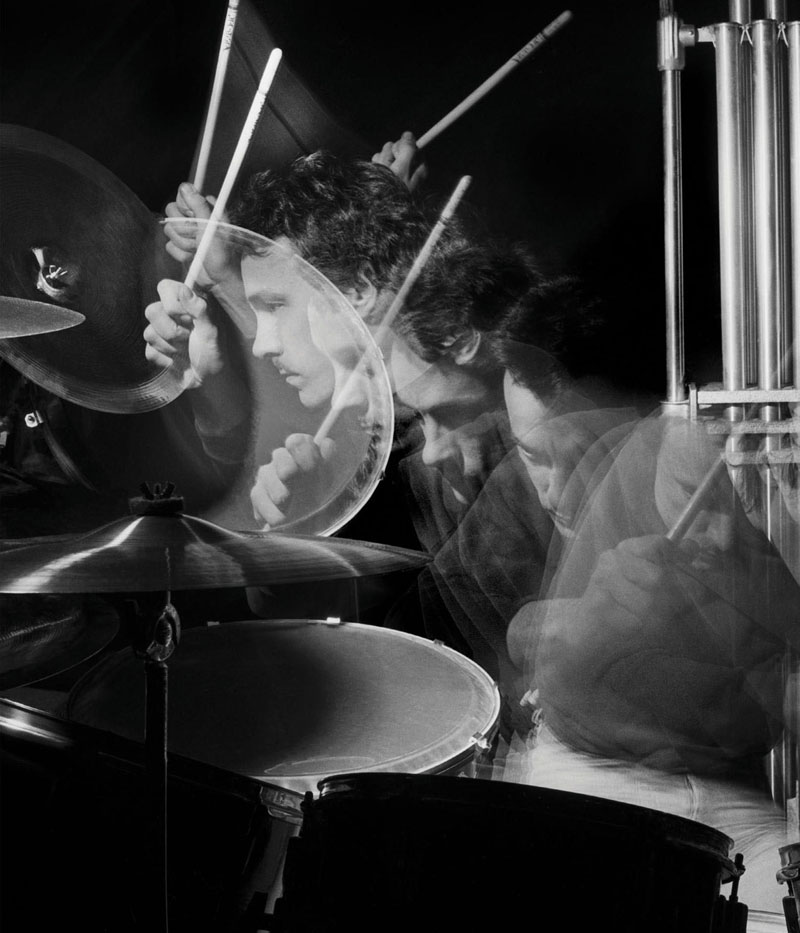
"If you think about it," says Lifeson, "Moving Pictures is the cute, sweet, happy offspring (of Permanent Waves)! We learned a lot about writing and how we work best to accomplish our goals so that an ambitious album such as Moving Pictures could be made without wanting to kill ourselves."
As LP Hartley once wrote, "The past is a foreign country; they do things differently there." With that in mind, more than 40 years is a lot of miles travelled. Little wonder, then, that the occasional question about that period in history draws perplexed glances or queries from Lee and Lifeson. Like Alex forgetting that they had aired two songs from Moving Pictures live before they even got near the studio, something Prog only learned about quite accidentally during a chat with producer Terry Brown. Ask the band now about the sublime, and possibly most Rush-sounding song on the album, the expansive-sounding The Camera Eye, with lyrics inspired by American writer John Dos Passos (who's also said to have partly inspired Grand Designs and The Big Money), and the first thing Geddy can recall is the Christopher Reeve Superman movie.
"The thing I remember most about that song was playing around with the sound effects and overlaying movie soundtracks for the beginning and the ending," he says. "It was fun shaping that kind of soundscape. Because it begins with a streetscape, we used a bit of dialogue from the Superman movie. We'd been watching it, I guess, and there's a line that you can hear in the background that's right out of that movie. So I remember creating those moments, but I don't remember a hell of a lot about writing the song."
"We were looking for moods," adds Lifeson. "I do remember that much - moods that might suit the wide-eyed perspective of the first half and build to a climax for each section. But it wasn't a conventional construction for a song by any means, and that's us saying that."
"I know how people perceive that album now," says Lee. "And it is a landmark record, but when you're writing a song, even those songs, you still vacillate between these moments of confidence and then moments of doubt. So, you waver between those two points until you hit something that you know works and excites you. But with The Camera Eye, because of the nature of the way the lyrics were on paper - it was more like prose - we approached it with the mindset of, "What's the best way of explaining this?' It needed a different approach to, say, something like Limelight, which was a much more obvious beast: verse, chorus, verse, chorus.
"And that all bleeds into our decision to stop the concept album thing - that was a big deal. We started to look at writing as a series of individual concepts, a series of smaller movies, in a way, which is what led to Moving Pictures and certainly to a song like The Camera Eye."
For a lot of listeners, one of the highlights of Moving Pictures is the consistency of Neil Peart's lyrics around that period. From Permanent Waves onwards we saw a distillation of Peart's words; he was more concise, less broad strokes, and in a song like Limelight at his most revealing.
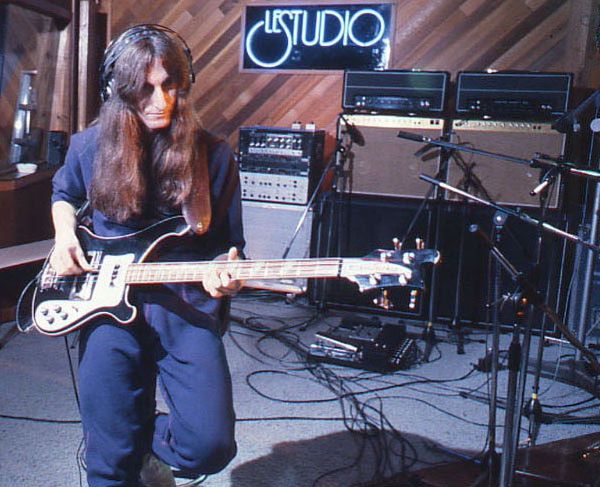
"I remember his writing in that period was very concise," says Lee. "And although there always was a little bit of back and forth about one line or another, I don't recall any major surgery or lyric changes around that time. As things progressed in our relationship, as singer to lyricist, that eventually changed, and I became more of a sounding board for him. Sometimes we would rearrange things, but I think for the most part in Moving Pictures, what he wrote was pretty much how we built the song. There was no major surgery going on. It was just our job to make a soundtrack for each one, to create these vignettes."
Hold the moment. It's a hazy afternoon up at Stoney Lake, a warm enough summer afternoon that the barn doors are open to let the daylight in. Neil's off in some far corner of the estate, pen poised over his notebook, scratching away at some lyric ideas. Inside the barn there's the familiar buzz of guitars and the low boom of Geddy's bass riffing around a song, trying to find a way in.
"What was that?" asks Lee suddenly, looking up at Alex like a dog who's just spotted a hare.
"Huh?" says Lifeson, who is already playing something else, willing his guitar to take him on to somewhere else.
Geddy, with the patience of a father who's told his son to turn the music in his bedroom down one too many times, holds up a hand to pause proceedings and walks over to the tape machine spooling and whirring silently in the corner, a constant in these frenetic writing sessions. The tape plays back and there, in the mash of arrangements and notes, is a diamond in the dirt: the opening riff to Limelight, intact, polished and bright. It was as if it had just fallen out of the sky and into their laps.
"It was pretty much like that, yeah," admits Lifeson with the kind of shrug that suggests he stumbles upon $50 bills each time he leaves the house.
"So I go wind the tape again," says Lee with a theatrical sigh. "And there's the opening to Limelight. And that's exactly why the tape was always on. Because before, if we used the tape and it wasn't rolling, Al would play some amazing thing and I would say, 'Holy shit, that was so great! Can you play it again?' And he'd go, 'Huh? No..."
Lifeson: "I was already on to the next thing or the next version of whatever it was, that's my problem. I just sort of impulsively play that way and it just keeps moving forward."
He isn't kidding. Prog once sat up very, very late on the balcony of a gilded hotel in Beverly Hills with Lifeson during the mix of the Clockwork Angels album, and as we made our way industriously through the mini bar and the sweet scent of smoke wreathed around us into the purple Californian night, Lifeson played his acoustic guitar mellifluously. Beautiful notes and arrangements went pealing away, intermingling with the wisps of West Coast dope someone had handed him earlier. There were three or four distinct moments when Prog stopped to ask what he was playing; not that he had any idea, he was just playing. We could have used a tape machine that night.
"Now I think about it, it's just the same with my guitar solos," says Lifeson. "The first five takes were always the best ones for the material. And then after that, I would just start repeating myself and I wouldn't get the right vibe up, and then it would get to the point where I couldn't objectively think of those pieces and put it together. And that's when I get kicked out of the studio. Then these guys and the producer - whoever - would take the solos and they'd start snipping it all up and going through a bunch of permutations until they got the one solo they needed, and then I come back in. First of all, I'd go, 'That's amazing! I played that?' And the second thing I'd say is, 'Fuck me, I'm gonna have to play that live!""
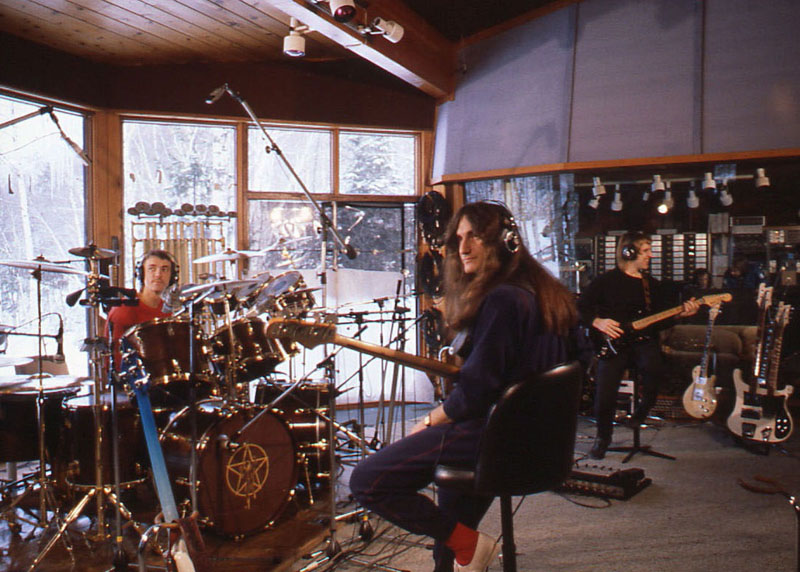
Correct us if we're wrong, but it sounds like the bass player wrote Red Barchetta. The question makes Lifeson cackle and Lee shoot Prog a look like he's just found us stuck to his shoe.
"I think you'll find that Al and I both wrote that song," he says. "I clearly remember writing the middle section: I remember writing that part on acoustic guitar. And then the whole 'wind in my hair' part, that whole section, but I think the main chordal pattern was Lerxst [Alex], and I just had room around that arpeggiated section where I could noodle. It gave me a lot of latitude. That's why it sounds like the bass player wrote it."
Lifeson: "I got to play the harmonics in a steady pattern that gave it a little bit of stability, while Ged and Neil were playing around with those accents, going off beat. We did that a lot over the years, where they would sort of go off and become the lead instruments and I would lay back and try to anchor it with an acoustic or with harmonics. Red Barchetta had that."
Lee: "It was one of those songs where it might have been built on a more conventional sense of timekeeping, and we would listen back to it and think, 'Well, that can be more interesting. Yeah, why don't we start messing around with the time and that's how it begins?' And then Pratt [Neil] and I go off on this tangent and instead of landing on the beat, we can wait and land on the back of the beat. So, it was all in aid of being unpredictable."
"Naturally, being Rush, we took it too far," says Lifeson. "Years later, when we were constructing songs on the computer, if we were putting an arrangement together... well, then we could have all kinds of fun moving the beats around. But then we'd go to play it and everybody would be cursing it. Those are the parts that were the hardest to remember live and where most of the train wrecks came from. Like Earthshine, you know? Great song but so fucking hard to play live, because there was one chorus that was different so then it pushes the other two choruses. That could be a mess live."
It's late when Lifeson gets back to the barn one night, driving the five hours up from Toronto. Inside, Lee and Peart are beaming. They've written a new song they think might work for the album. Would Lerxst like to hear it?
"I stood there - hadn't even been in the city that long," remembers Lifeson. "And it's the worst thing you can imagine: a fucking song written by the rhythm section! I have to fit a guitar part over this?"
His comic incredulity is fitting. Does he remember his reaction the first time he heard the jumble of riffs and pacing that was YYZ?
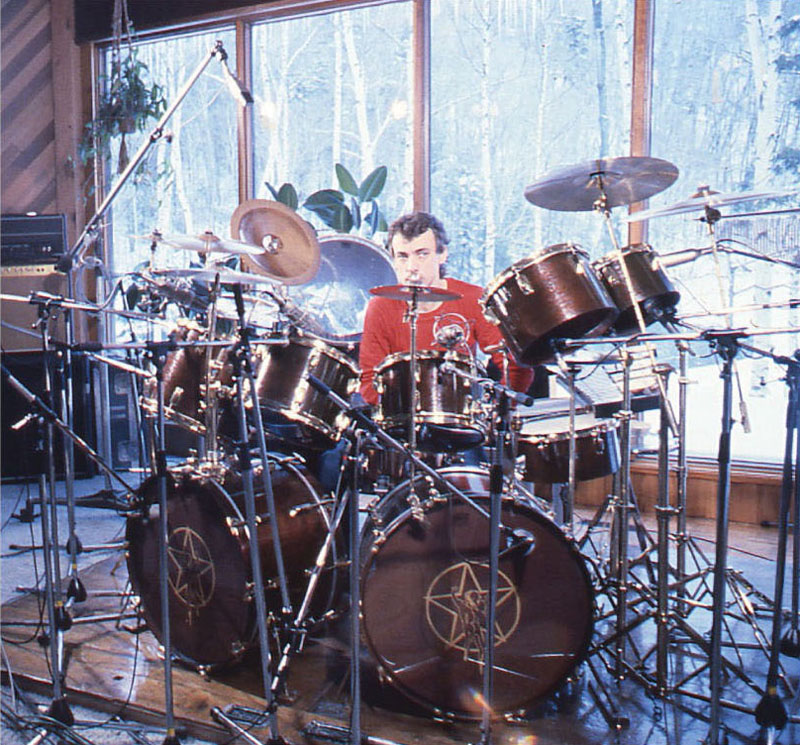
Lee: "Pratt and I had gone into the barn and we just started jamming to loosen up. I got this idea for that main riff, and so we just went back and forth. Then, before we knew it, we were putting a song together. Pratt would say, 'Hey, it would be great if we had a part that was a bit more mellow now.' And I'd say, 'Well, I can use keyboards here.' And then, almost out of nowhere, we had this song."
"Then I had to learn that stupid bass part and transpose it to guitar. Thank you?" Lifeson says, laughing.
"One of the really cool things about that song, though, is that we were on a break and had gone home, and a friend of mine flew up to pick us up in a small plane. We were flying back to the city and, approaching the airport, they have this identifier, and it's Morse code. It's that 'dada, dada, dada' signal that would be the intro to the song. I don't know - was it you, Ged, or was it Neil? But somebody said, 'Hey, that'd be a cool way to start the song: with that rhythm, the identifier.' And then, when we went back to the studio, we fit it in. And that's such a signature."
For a lot of people, the introduction to Rush's biggest-selling record came with the deep, sonorous hum of the bass pedal that brought Tom Sawyer kicking into life. Prog has stood in Madison Square Garden as that selfsame pedal opened the show and watched grown men wilt, bloom and throw beer over each other, simultaneously utterly in thrall to the booming opening chord and what it might bring. Tom Sawyer has become legion to Rush fans and never out of a live show since its inception on that first album tour. Naturally, this being Rush, it almost never made the album.
"I mean, when we were working on Tom Sawyer, actually for the longest time, it was the worst song on the record," Lee reveals.
"We had more trouble with that song than almost any other song. I had real doubt about whether the song was working at all. I remember when we came to do the solo, and we're having a lot of trouble getting a sound that you were happy with. All of a sudden, [album engineer] Paul Northfield kind of jumped into action and came up with this idea of miking the stereo speakers and doing your solo in a stereo spread. Then it gave it that kind of tubular sound. And then it finally came to life. But when we finished and were even mixing the song, and we'd had problems with the computer that was running the mix, so we all had our hands on different parts of the console operating it manually because we didn't trust the fucking thing. We'd do a take and everybody was holding onto their section of the console. But even then, I remember having doubts about that song. Then when we heard it back in full, it was like, 'Holy fuck!' when those bass pedals came in. It was like, 'Okay, this works. But up until that point, there was a lot of doubt about that song."
And it was Tom Sawyer where he first laid down his infamous Rickenbacker bass and picked up the Fender Jazz. That was pretty much heresy to a lot of Rush fans.
"Yeah, I just couldn't get the bass sound to work on that song. It was just weird, because I use the Rick on pretty much every other song on the record, but it wasn't working on Tom Sawyer whatever we tried. There was a lot of fiddling and I think it created a negative association towards Tom Sawyer, but not when it was finished. It genuinely felt like a whole other song."
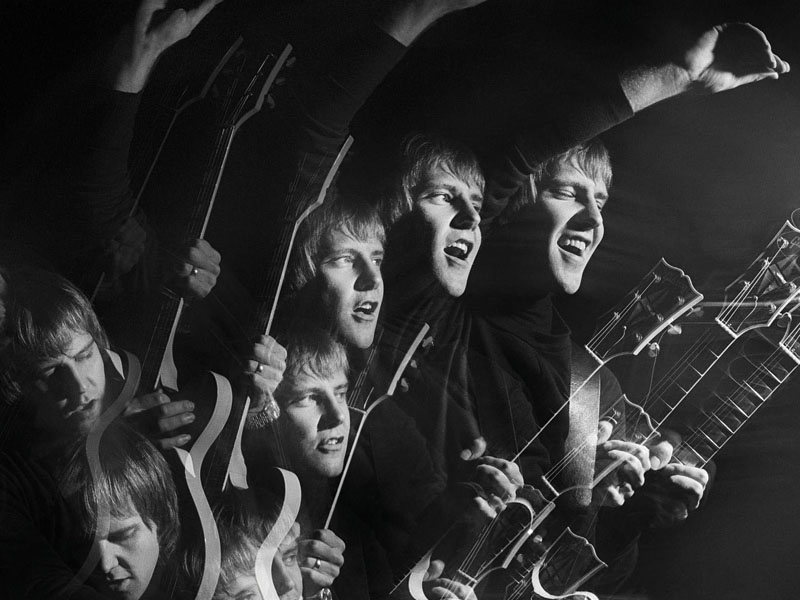
Lifeson: "It went from being this immovable thing to the obvious candidate to open the record - that opening and then Neil's drums. But I do remember it being a real relief to tick off the chalkboard."
Lee: "We always had a chalkboard. We'd put the songs up and the parts left to record and would check them off as we worked."
Lifeson: "Rupert Hine (producer on Presto and Roll The Bones) had a different kind of process where he used coloured Post-It notes for each of the jobs. The drums were maybe yellow, the vocals were maybe red. The guitar was maybe blue or green. And he would stick them all on the screen, on the window between the studio and control room. And as you finish the job, you took that one off until the window was clear. You could literally watch the progress of the album."
Lee is quietly astounded. "I have a photo of that, and I could not remember what the notes were for! Yeah, like a musical advent calendar leading up to the finished album."
Lifeson: "Did you tell him about MacGyver?"
Lee: "I didn't. You tell him about MacGyver."
For all their po-faced legacy, this is what it's like to sit in a room with Lifeson and Lee as they toss dry bon mots back and forth with faces set like they're playing a hand of poker.
"It was also used as the theme song for the Portuguese version of [TV spy show] MacGyver in Brazil."
Lee: "That's right."
Tom Sawyer?
Lifeson: "Tom Sawyer, yeah. We went to Brazil and we couldn't figure out how the fuck we got so popular there. And it turns out that they had overdubbed the original music for the TV show and had changed it to Tom Sawyer. And so everybody wanted to hear that song, because everybody knew it from fucking MacGyver!"
From the arduous journey that was Tom Sawyer - not only the album's opener but one of the first songs to be written for the record - we now go to the last, the sprightly sounding Vital Signs. Conceived and created as if on a whim in Le Studio, its energy sparking off around the room, the giant picture windows picking out the lake below.
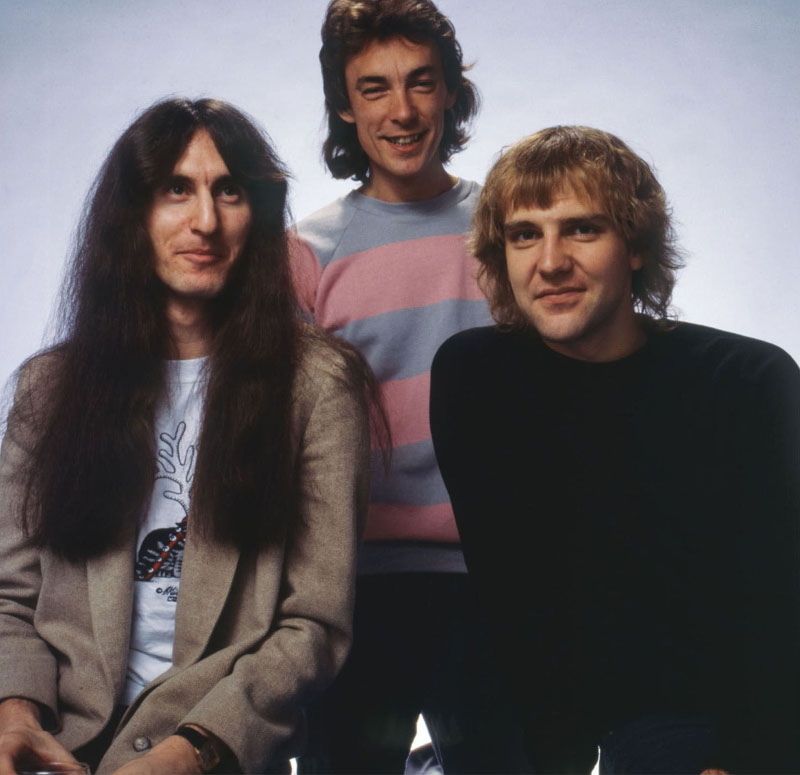
"It was the last song we wrote on the record, and we wrote it in the studio. It was a very spontaneous moment, a really nice thing," says Lee. "After labouring the songs for a few months, just to go in as the three of us and see if we can just write a song, that's a thing. We did the same thing again with New World Man, it was written like that. Certain albums have that one spontaneous song. And it's funny because that song, those types of songs, end up being a precursor for some styles that we might do on the next record. Like a segue, almost. So, Vital Signs really kicked us off towards Signals without us even knowing it."
It's the summer of 1981, the first set of acclaimed Moving Pictures shows are done, and the band are back at Le Studio for yet another mix. But no hats and scarves or baying mobs this time: they're here to work on the live mix of Exit... Stage Left, the album that was originally meant to follow Permanent Waves. The atmosphere is electric, the sun is high and so is the band's mood.
Lee: "That was a really fun summer. We had the barbecues, we were out on the lake and because we had tonnes of time on our hands, because it was a live album mix, we didn't have to be in the studio until we had to listen to it. And Le Studio being Le Studio, it was during those mixing sessions that we wrote Subdivisions. We were bored, we had a keyboard handy, and then we went back out in the autumn to promote Moving Pictures and Exit... That was a good time in our lives."
It's getting late; Lifeson has to go and meet family, Lee's got another meeting he has to take. One more memory before we go from the final mixdown of the record and as the band were trying to push the album home. The weather's picked up, it's December 1980 and there's a blizzard coming in over the mountains on the lake at Le Studio. There's trouble inside the studio, too.
Lee: "We were having some weird issues with the electronics of the place because they had just gotten their new SSL board there. It was a bit buggy. It was one of the first SSL boards in the country and it was freaking out a little bit. I remember when we were mixing Tom Sawyer, Vital Signs and Limelight, we were having all kinds of crazy problems because there were these electronic spikes. They were actually changing the mix at the very last minute and we genuinely thought we were going bonkers, that we'd been in the studio too long, until they figured out what it was."
Lifeson: "It was a grounding issue."
Lee: "When we'd arrived it wasn't super-cold. But by the time we left it was the dead of winter and there's all kinds of moisture in the ground and a lot of snow. It shifted the atmosphere and so it was shorting out the desk. You'd see these spikes on the computer screen; you'd see each track had shifted when you hadn't programmed them to move. You don't want that when you're mixing because you're already crazy enough by that point!
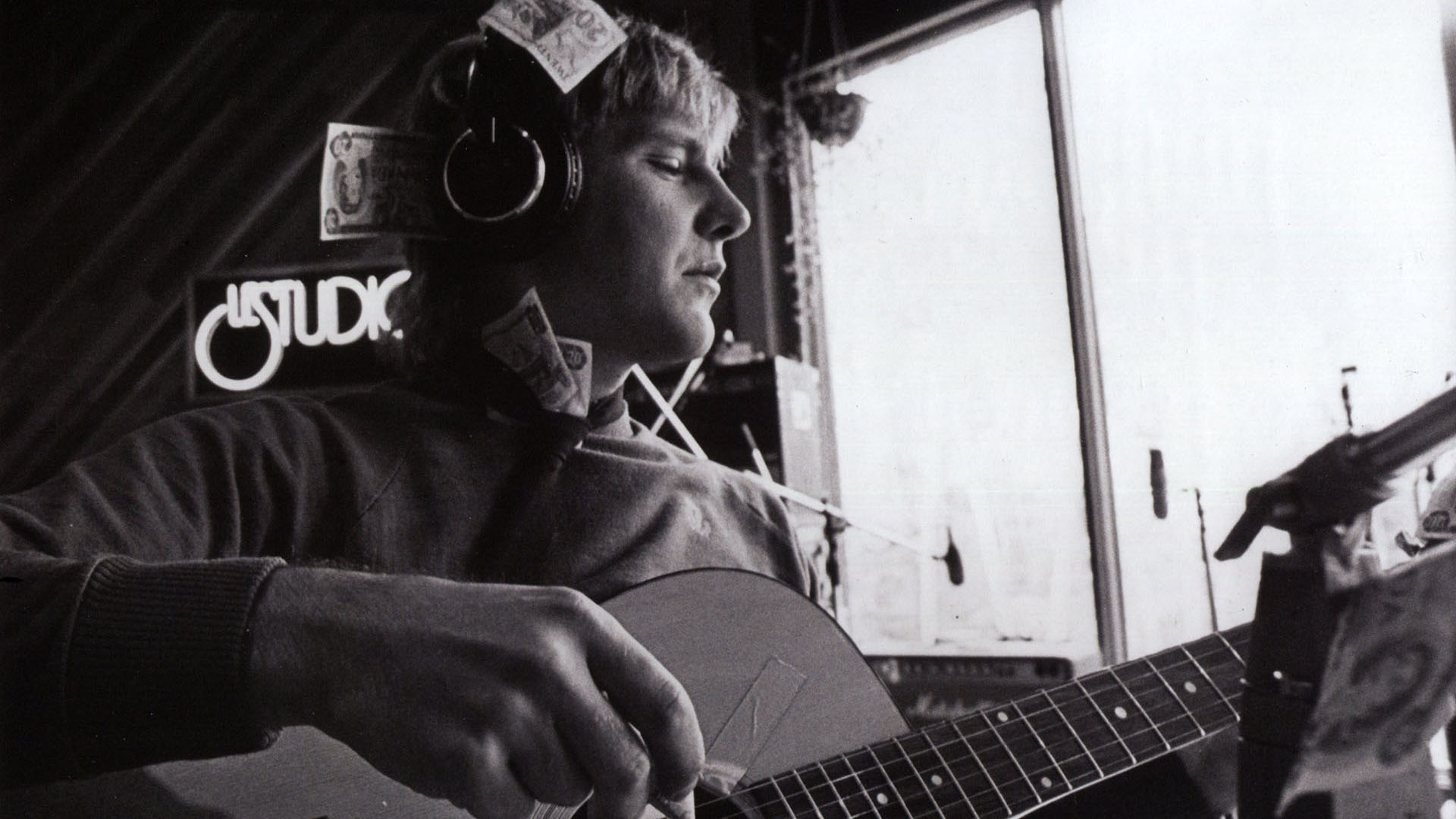
"I remember leaving Le Studio that night and I had to get back to the city as I was meant to be heading off on holiday with my family, and by the time we left Morin-Heights this huge snowstorm had hit. I had Broon with me and I was in my old Porsche trying to negotiate these roads in this halflight with the snow just ricocheting off my windscreen. That's sort of my enduring memory of the end of those sessions and that album: just trying to make it home."
And now?
"I mean, it's funny because those two records, Permanent Waves and Moving Pictures, are always connected for me. Yeah. Because one spurred the other in so many ways. They were both really a culmination of all the trial and error that had gone on a lot of the records before it. And after Exit... Stage Left, it was time for something else. It was a more turbulent process from then on in, because there were these other layers in our music, other textures, and the records became much more difficult to make over the next seven years.
"I guess what I'm trying to say is that after Moving Pictures, I don't think we were ever the same band again."
"It was a great album to make"
Producer Terry Brown gives a view of Moving Pictures from the other side of the glass.
For some he's still the Rush producer - and Terry Brown was immortalized by the band in the live Broon's Bane from their Exit... Stage Left album. He was behind the glass handling co-production with the band from 1975's Fly By Night through to 1982's Signals. Here he recalls the months spent creating Moving Pictures.
What struck you first about the album demos - did they feel as strong as the material on Permanent Waves?
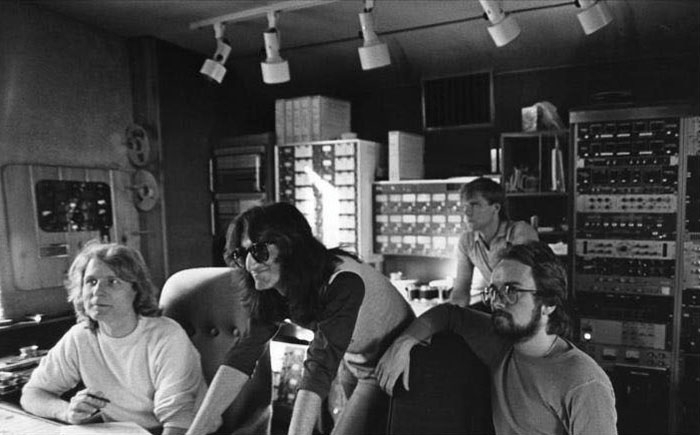
Rush were constantly evolving, so the demos were even better and the material had a more refined edge. It was more commercial fairy dust!
Was there any hesitation about returning to Le Studio to make the record?
We were so well looked-after at Le Studio while recording Permanent Waves that we couldn't wait to return for Moving Pictures. Between a great-sounding room, on-tap cappuccinos and the best French cuisine, it really was a no-brainer.
How long did it take from the demo stage through to the final mix?
The demo stage was spread over a few weeks, and bear in mind some of the tunes were road-tested on the previous tour. We loaded into the studio at Morin-Heights in autumn/early winter, well prepared, and spent about 10 weeks recording and mixing.
Weren't there some technical issues with the studio equipment this time around?
We did have some technical issues, but it's to be expected when you're pushing the latest gear to its limits. I mixed Moving Pictures to a digital format, which was groundbreaking, since the digital systems were unproven at that time. We used a Sony 1610 digital processor, which was hooked up to a three-quarter inch video recorder. At times little glitches would appear on the playback, so we'd have to repeat the process.
Which songs started to properly reveal themselves in the studio first?
We started setting up on a cold Friday and by the time we had finished, Neil's kit sounded amazing. We were all set to record and cut the bed track for Tom Sawyer on the following day. If I'm not mistaken, we cut Limelight and Red Barchetta next.
And which were harder to capture?
If my memory serves me correctly, The Camera Eye and Witch Hunt were a little more difficult to nail down, in as much as they were moodier pieces and required different sensibilities. Witch Hunt, especially, was more of a studio production. This tune had many overdubs - not least of all the multi-tracked 'mob', at the beginning of the tune, who were recorded outside on the lawns overlooking the lake.
The band were evolving, even on from Permanent Waves. Did they bring anything into the studio that surprised you?
The band always surprised me to a certain degree - when they came into the studio for Moving Pictures, they were pushing themselves beyond their comfort zone. I think most noticeably on YYZ, which bounds with energy and finesse right out of the gate.
Overall, was this a happy album to work on?
Moving Pictures was a great album to make: the band was full of enthusiasm, the crew kept the gear humming and Le Studio was a very creative environment. I still love it; it stands up pretty well for a 40-year-old.
Re-Moving Pictures
Rush album cover artist Hugh Syme explains how he devised the concept for the cover of Moving Pictures.
From 2112's infamous starman, through floating brain hemispheres and a kid casually kicking a skull, Hugh Syme has always been on hand to bring Rush's musical fever dreams to life. Working for years in close conjunction with drummer Neil Peart, Syme's work became synonymous with the Canadian trio, latterly putting a new, re-imagined spin on some of their classic albums.
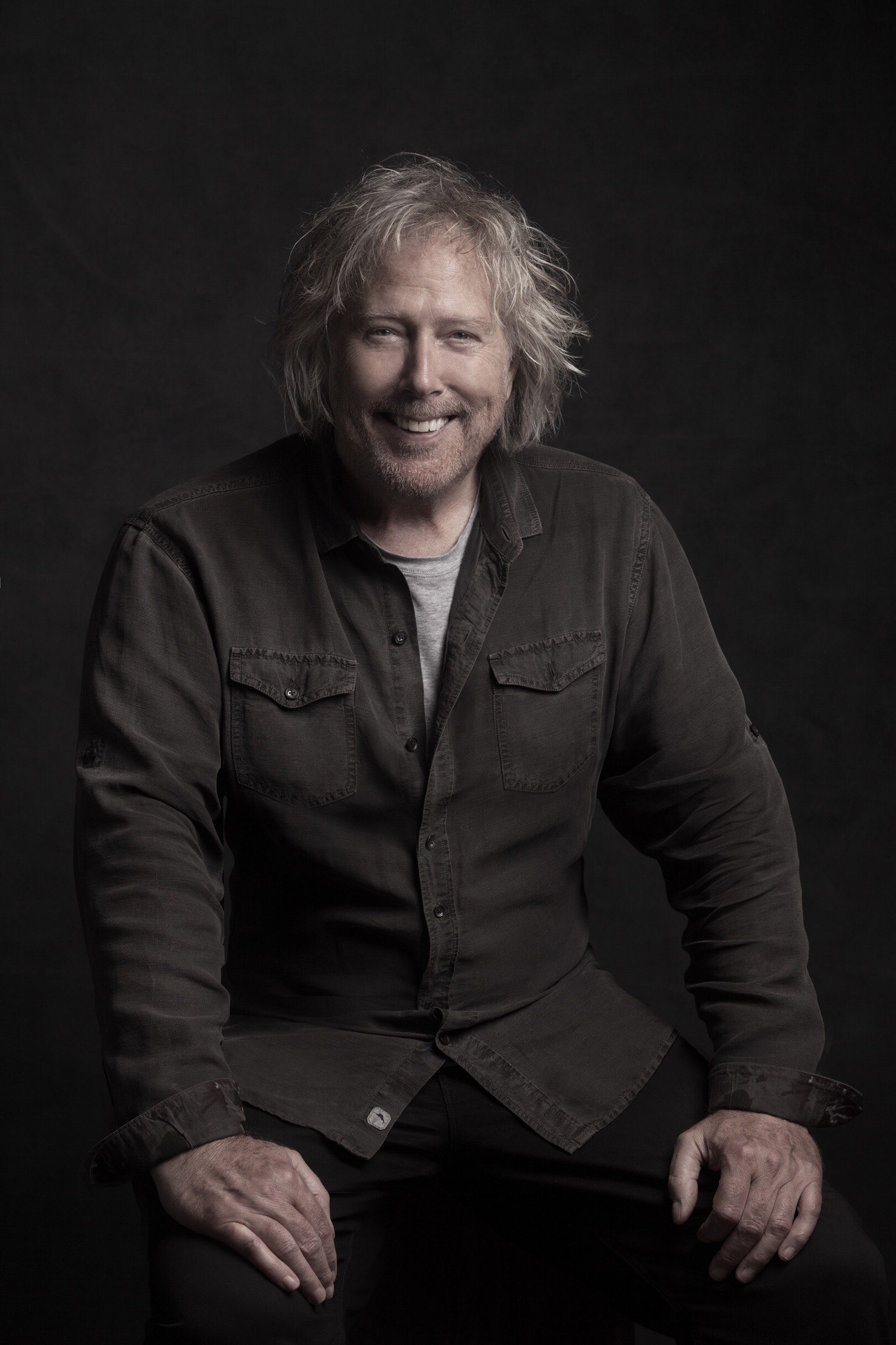
When did you first hear the words 'Moving Pictures'?
I remember exactly where I was: sitting in my friend Gail's home in St Catharines, Ontario, when Neil called me with the album's title. I also recall my immediate resolve on the cover's direction.
Which was?
Men in red coveralls actually moving pictures. The additional layers and triple entendres would follow.
Did you spend much time at Le Studio as the band were working on the album?
Deborah Samuel and I went up to shoot photos of the band for the album. We stayed for about three days in the studio's guest house. We also sat for two hours in a paddle-boat while Deborah shot Neil playing his red Tama kit on a raft in the middle of a nearby lake for a Tama ad. A private, and tireless, drum solo echoing off the surrounding Laurentian Mountains. That was a good day! Though the highlight on that trip to Morin-Heights was being asked by the band to play PPG synth on Witch Hunt.
You finally settled on two concepts for the record: literally moving pictures and making movies. Was there ever a doubt which one would be the actual cover?
No, that order made sense to me. The three movers actively moving pictures on the front, then [on the back] they're taking a break, as we reveal a film set in an overview for context.
Who came up with the idea of using the government building as the backdrop?
I did. A happy and timely accident. I remember driving north on University Avenue in Toronto and was struck by the legislative building at Queen's Park, whose architecture featured three distinct arches, each supported by three pillars, and the three arched windows on the overhead mezzanine. You must remember that the concept of 'three' was emerging as a recurring motif for the band at the time and I thought, 'Well, it won't hurt to ask.' And to my delight there was no hesitation, permit or fee required. Simply that we shoot on a Sunday when parliament wasn't in session.
You've re-imagined the cover and created new illustrations for some songs for the reissue. How was that?
For all the 40th anniversary box sets, happily. It's been a real delight every time, and a challenge to me personally to refamiliarise myself with Neil's lyrics, and to reflect the themes of each song with today's skill sets and mindset. It was a joy and privilege then - as it continues to be all these years later.
Is that really Neil in the middle of the shot on the back cover? Or is that a myth?
I love a good mystery, don't you?
Cover Act
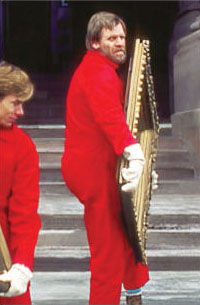
Kelly Jay was the front man of Canadian rock band Crowbar (not to be confused with the US sludge metallers of the same name). Before his death in 2019, he told Prog about his appearance on the original cover of Moving Pictures.
"I knew Geddy and the boys; we travelled in the same circles. We were [former Canadian PM] Pierre Trudeau's favourite band and we had a large following, but not as big as Rush. We'd bump into each other, but the main connection was photographer Deborah Samuel, who I - and my wife at the time, Kerry Knickle - knew. She asked me to come and be one of the guys involved in the shoot. I didn't know that much about Rush's music. We were like Mozart and they were like Wagner [laughs]. They had a lot of notes!
"It was filmed in front of the Ontario Legislature. It was a Sunday and the place was closed, nobody except us in the parking lot. We were there for quite a while. My wife was the makeup lady - you'll see her on the inside cover.
"Deborah is a phenomenal photographer and an amazing director, and the idea for the sleeve was superb: the totalitarian Russian gulag carrying the paintings around. My wife and I did a lot of fashion photography back then because my other work with her was making feather hats. So it was just another fashion shoot!
"We didn't get paid but we did favours back and forth for each other. Afterwards, Crowbar carried on as a band, we had a lot of nice accolades and our song Oh, What A Feeling seems to have become a classic. I've written 500 songs since then.
"I've got a copy, but I have never heard the record. It's a cool piece of art and the amazing thing about it all is that it leads people to check out why did they do it, who was involved, and you discover a lot stuff - however, you're the first person to want to speak with me! Up until now, nobody knew that I was on that sleeve. It used to be one of the great bar bets: who's that on the Moving Pictures cover? The mystery seems to have lived on."
The Camera Eye
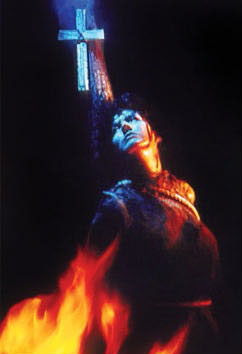
In an interview from 2013, photographer Deborah Samuel explains how she came to work with Hugh Syme and even ended up on the cover of Moving Pictures!
"I was living in Toronto at the time and I was shooting entertainment and doing fashion as well. Hugh Syme asked me if I'd be involved on Permanent Waves to style the girl on the cover, which I did. It was before Photoshop so we had to put four negatives together in the dark room. So we had to print it all on one piece of paper - an adventure in itself! Hugh put himself on the cover: he's the guy who's standing next to the stop sign, waving.
"Hugh then asked me to shoot the cover for Moving Pictures and as he had been on the cover of Permanent Waves, it meant that I went on that. I became Joan Of Arc and it became a joke between Hugh and I. Hugh and Neil Peart had brainstormed the pictures they wanted and it became a pun on pictures that moved people. The Coolidge picture of Dogs Playing Poker was a favourite of Neil's - he had a good sense of humour.
"On the day, the pictures had been blown up to enormous sizes and framed so the movers were moving real pictures. It went really smoothly - we had a big truck with everything in and so many hours to shoot it. We brought in a number of friends to participate and set it up to create the scene.
"The Joan Of Arc setup was done shortly before; we got an old pole and put it up in the studio. I got into burlap and stood in front of the pole. I had a shutter release cable in the back of my pants and we set up a pie plate under the lens and put lighter fuel into that. Hugh set it on fire and the perspective made the flames look huge, like a bonfire - they were just three inches big.
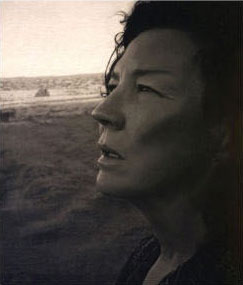
"On the day it was fun; we were all 30 years younger and happy: 'I'm going to be on a Rush cover!' Everyone was related, or a friend. The band were not there [though]. I didn't know them terribly well, but I did their shots with a Monobloc, a piece of equipment that takes four shots a second. That was another pun on 'moving pictures'.
"I did a lot of album covers at that time, it's how I started in the business. But it's always rewarding to see the complete work. I never thought much of being Joan Of Arc, but it's become much more of a story in the last 10 or so years than it was at the beginning. I've gotten more fan and interview requests, probably because of the anniversary [Time Machine] tour in 2011, and it became huge! It's kinda odd. It's certainly a role that I understand and when I was a kid she was an important figure to me, I never knew why. It's kind of an early feminism, and being burnt for your beliefs... in my line of work that's something you've gotta take on!
"I worked for over 20 years in editorial portraiture, fashion, entertainment; I travelled at lot and lived in different places. Nearly 20 years ago I moved into fine art. I always had that alongside commercial work. I was one of the photographers who always got the wildest jobs as I can deal with people [laughs]. My fine art work became more important.
"I haven't listened to the record recently. I have pretty eclectic tastes in music but I appreciate Rush; they were one of the nicest bands to work with, down-to-earth and professional. All the really good people are always like that. They've weathered all storms, and working with young bands in LA, they don't get that.
"I think the sleeve is a classic. The concept weathers time, the music weathers time and the artwork weathers time. There's a lot of admiration for it. I get a lot of emails and enquiries and it's a record that defines a certain part of your life. A lot of young men are particularly influenced. It was part of the culture, make-up and voice."
Moving Pictures 40th Anniversary Review: A stellar unreleased live set, toy cars and re-imagined artwork? The Canadian trio's 1981 masterpiece gets the reissue treatment.
By Dave Everley, illustration by Kevin February
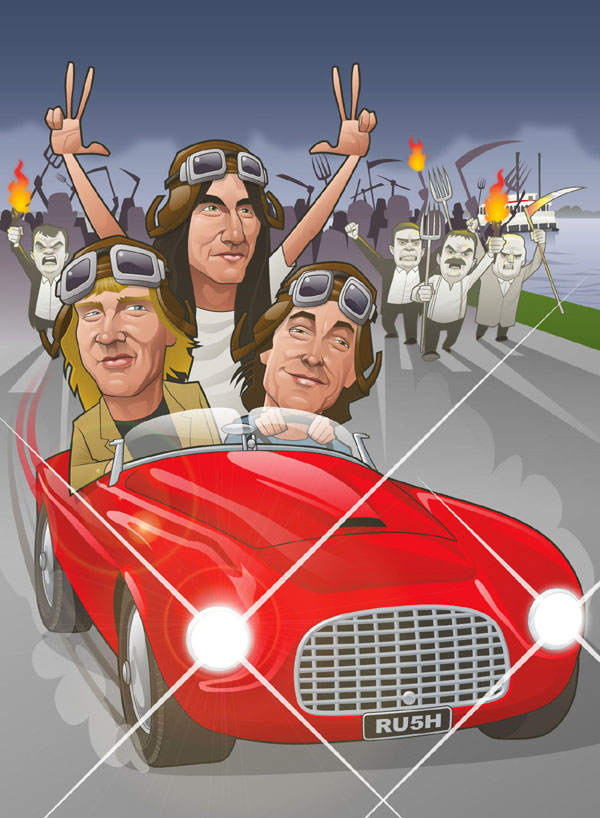
Rush's Snakes & Arrows in 2007 featured the greatest in-concert film ever. Created by South Park geniuses Matt Stone and Trey Parker, the minute-long clip saw the four potty-mouthed kids from the animated TV show rehearsing the Canadian trio's 1981 single Tom Sawyer in their guise as Lil' Rush. After some amusing bickering over the lyrics ("I am Geddy Lee and I will sing whatever lyrics I want!"), they eventually launched into it properly... at which point it instantly, and brilliantly, segued into the real-life Rush playing the same song on the stage, in front of the audience, in the flesh.
It's telling that Parker and Stone picked Tom Sawyer. That it's a solid-gold classic is undeniable, but it also kicked off the album that stands as Rush's greatest pivot point - one that bridged their old school progressive past and their slick, mainstream-adjacent future. As this lavish 40th anniversary reissue shows, it's not only their most complete album, but also their most significant.
The previous year's Permanent Waves had scaled back the lengthy epics, and even spawned a hit single in The Spirit Of Radio, but it was still a recognizable 'prog' record, musically and lyrically. Moving Pictures was no less complex, but it presented a Rush that was fully ready for the oncoming decade.
The keyboards that had become a prominent part of their armoury were shoved front and centre here. The first sound on the album is the fuzzed-out wall of synths that introduces Tom Sawyer. Elsewhere, the perpetually-in-motion The Camera Eye - at 11 minutes, the closest this album comes to an old-school Rush epic, in length if not construction - is punctuated with washes, squelches and jabs of electronic noise.
Lyrically, too, it marked a shift for Neil Peart, with the drummer largely dispensing with allegorical tales of futuristic civilizations and Greek myths. The exception is the Top Gear-goes-sci-if parable Red Barchetta, whose music conveys the exhilaration of an illicit car ride more convincingly than its hokey lyrics. Conversely, Limelight is the drummer at his finest and most revealingly personal. 'I can't pretend a stranger is a long-awaited friend,' sings Peart proxy Geddy Lee, bringing his band mate's well-documented social discomfort to life.
Moving Pictures is impressively front-loaded, to the point where its stellar back end often gets overlooked. Witch Hunt (Part III Of Fear) remains one of the darkest things they recorded. Even better is closing track Vital Signs, whose relentless electronic pulse and Police-esque white reggae vibe seeded the DNA for Signals and beyond.
For all that, Moving Pictures' legacy was assured a long time ago, so the question is: what does this reissue offer? The answer, at least for anyone with a hefty chunk of money to throw down on the super-deluxe edition, is a 44-page photo book, a pair of Neil Peart branded drum sticks, all manner of posters and pin badges plus a model Red Barchetta car on a stand.
Thankfully, there are less wallet-emptying versions containing the proper gold, specifically Live In YYZ: an unreleased set recorded at a hometown show in Toronto's Maple Leaf Gardens on March 25, 1981, two days before the bulk of the same year's Exit... Stage Left album was captured in Montreal.
This later recording trumps its illustrious predecessor on pretty much every level. Running to over two hours, and featuring the full set list in its original order, it's a clearer representation of Rush in full flight than the patched-together ...Stage Left. Sonically, too, everything about it is brighter and punchier, not least Geddy Lee's pithy between-song links. Best of all are the unexpected and unheard musical twists, such as the brief reggae-fied version of Working Man that leads off the early-70s medley towards the end of the set. Why this show has never officially been released before, only By-Tor knows.
While what is on this reissue is unimpeachably tremendous, there's the perpetual question of what isn't. Rush have always been parsimonious with their outtakes, mainly because they always claimed there weren't any. Still, there must be rough sketches and alternate takes lying around the vaults somewhere. As men of (musical) science, they must be aware that their workings are as crucial as the result. If ever a band could do with pulling back the curtain occasionally, it's them.
All that must remain a Rush devotee's fantasy. What this latest edition of this landmark does offer, via that stellar live recording, is enough to keep all but the most demanding fan happy. It might not add anything significant to Moving Pictures' legacy, but it does give it a good polish.
Old Dogs & New Tricks
One of this year's biggest surprises has been the announcement of Alex Lifeson's new synth-rock project Envy Of None. With their self-titled debut album out now, the Rush guitarist, along with bassist Andy Curran and up-and-coming vocalist Maiah Wynne, tell Prog all about its inception and the very special tribute to Neil Peart that closes their first chapter.
By James McNair
The way Envy Of None's bassist Andy Curran tells it, the "humble origins" of the band owe something to a romantic little ditty titled Liquor & Whores. A 2017 single by Bubbles & The Shit Rockers, this country and western spoof delighted fans of Canadian TV sitcom The Trailer Park Boys, wherein actor Mike Smith plays Bubbles, a geeky, bespectacled Belgian who also happens to be a devotee of Canuck prog giants, Rush.
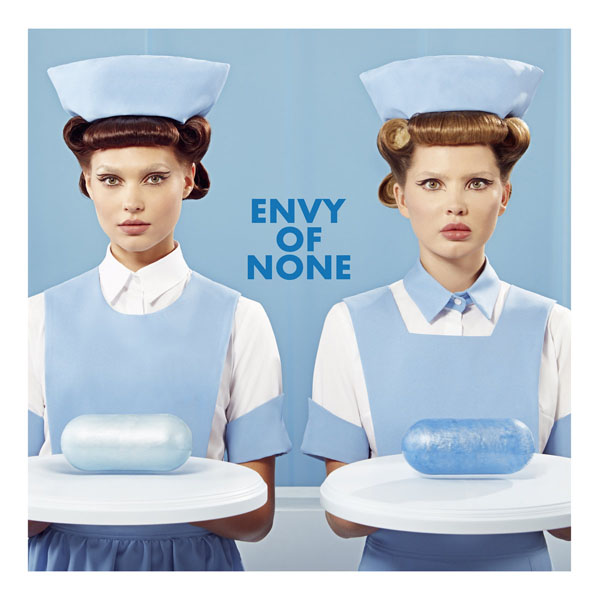
Liquor & Whores included Trailer Park Boys fan Alex Lifeson on guitar, and when he and Bubbles asked Curran to play bass on the song, it marked Curran and Lifeson's first musical union. Best known for his early 80s work with Canadian hard rockers Coney Hatch, Curran had known Lifeson for yonks and been his label-mate at Anthem Records, but Liquor & Whores broke the ice for more serious pursuits. In 2021, when Lifeson released the instrumentals Kabul Blues and Spy House via his website, Curran was honoured to play bass on the first original music wholly credited to a member of Rush since their drummer Neil Peart's tragic death to cancer in January 2020. "I was like, 'Oh, maybe this is crossing over into something...'" he recalls.
Happily, Curran's instincts proved to be correct. Both Kabul Blues and Spy House have since been reinvented as songs on the self-titled debut by Envy Of None, a new electronica and industrial rock-influenced band that features 25-year-old vocalist Maiah Wynne and second guitarist/multi-instrumentalist Alfio Annibalini alongside Lifeson, Curran, and session drummers David Steinberg and Tim Oxford.
Lifeson is the big name, of course, but he certainly doesn't want star billing. "I don't need my ego fed and I don't want to be the big shot," he tells Prog from his Toronto home studio. "This is very much a band and I just wanted to be a good contributor to great music. Working with such strong ideas, people and able performers as these guys, it was easy. You'll hear something different in these songs every time. I do, and I must have listened to them 17 million times."
As befits his status as an axe god, the backdrop of Lifeson's Zoom call comprises a wall of vintage guitars. Mindful of grave world events, he has tucked short blue and yellow jack leads into the neck of his T-shirt, "in honour of our Ukrainian brotherhood". Curran also tunes in from Toronto, while their American band-mate Maiah Wynne joins us from her studio space in Portland, Oregon, her red beanie hat pulled snug, and a cello and an acoustic guitar visible behind her. Prog mentions that it must be nice for Lifeson and Curran to have some youthful energy in the band. "Yeah, they're siphoning it off," quips Wynne. "Stealing my blood!"
It's Wynne's malleable, breathy voice that lends a real commercial edge to Envy Of None songs such as propulsive opener Never Said I Love You and the richly textured ballad Old Strings, but elsewhere, listeners may hear shades of Aimee Mann guesting on Rush's Time Stand Still, Nine Inch Nails, or Shirley Manson fronting Garbage. There are prog and gothic elements to the music too, making Envy Of None difficult to pigeonhole.
"Yeah, Alex and I had talked about stepping outside of our comfort zones in terms of what we might be expected to do," explains Curran of the album's layered sonics. "I've always loved 80s new wave and 90s alternative stuff, and if you listen to something like [Lifeson's 1996 solo album] Victor, Alex was writing that way even back then."
Wynne, a Colorado-born singer-songwriter who has released a number of EPs under her own name, comes from a folk and indie background, so Envy Of None has been a real departure for her, too. "I've written music for independent films and explored industrial stuff and heavier music through that," she says, "but this is definitely more trippy, gritty and dark than what I would usually write."
Going back a few years, Curran, Wynne and Curran's former mixing engineer Alfio Annibalini had already begun working together before Lifeson committed to the project fully.
"In a very serendipitous moment, I was asked to be a judge for an online music competition," explains Curran. "Maiah was one of maybe 10 different artists whose music I had to rate. I loved what she did, and next thing I know I'm on a Zoom call with her as a mentor.
"She explained that the gentleman she had been writing with had moved away, so I told her she had to network. Without missing a beat she said, 'Well, how about I do some songwriting with you?'"
The project evolved slowly via file-sharing, with Curran sending Wynne "a bunch of ideas" and a few lyric fragments, and suggesting that she developed the ones she liked best. "It was very collaborative and a lot of fun trying to find the puzzle piece that fit with certain parameters or keywords," she says. The first thing Curran and Wynne "really connected on" was Shadow, the kind of dark-side of-the-psyche trip at which EON excel. 'What do I do with all these thoughts?/ I'm breaking down in the middle of it all', sings Wynne.
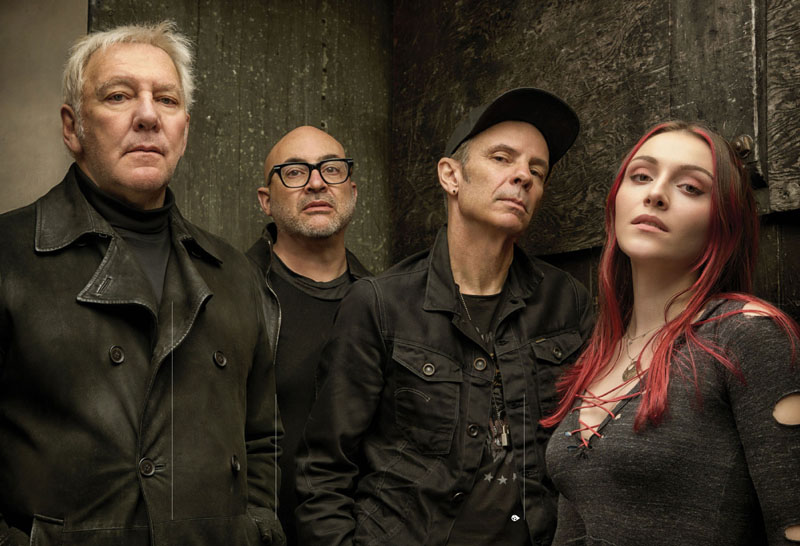
Lifeson's involvement was initially more tentative, the guitarist having downed tools while grieving for Neil Peart in the year after his death. "I didn't really want to do music," he says. "I didn't really want to do anything. But then Andy was like, 'Al, I know you're sitting around at home, so if you feel like recording some guitars in-between your rounds of golf, here's some material.'
"I have to admit it was very casual at first," Lifeson continues. "But Maiah's voice sounded so great and everything changed with the prospect of doing a proper album. Suddenly I felt [sharp intake of breath] 'I'm a musician again!' This is exactly what I need in my life. It felt so good to be doing what I'm supposed to do, what I've been doing my whole life since I was 12 years old."
Wynne, Lifeson and Curran agree that this naturally evolving, almost 'stealth' aspect to Envy Of None's gestation took the pressure off. "There was no deadline," says Curran. "No managers or record company people saying, 'You've got to do this by then.'"
While Lifeson contributed his parts at leisure - "A lot of the guitars on this record don't sound like guitars," he notes - the band were still operating under the knockabout moniker 'Middle Of Nowhere'. It was session drummer David Steinberg, Wynne says, who contributed the band name Envy Of None. Apparently it was a phrase he had heard while at Law School, and one originally coined by the Roman poet Ovid in the first book of Tristia, a collection he wrote while in exile.
"I think we liked the name Envy Of None because it says nothing about the music," smiles Curran. The sleeve art for the band's debut is pleasingly cryptic, too. Depicting two glamorous, 1950s-styled nurses each holding a giant blue pill on a tray, it's the sort of image Hipgnosis might have hatched for a Pink Floyd LP. "Definitely some kind of metaphor," laughs Wynne.
Much more important, of course, was the tight-knit, easy-going working relationship between Envy Of None's members, and both Lifeson and Curran are quick to praise Wynne's talent and professionalism.
"With Maiah, the gap in years is inconsequential," says Lifeson. "It was just incredible how in tune with each other we were despite our many differences. She was so mature and smart and thoughtful."
"Yeah, one of the conversations Alex and I had after I first introduced him to Maiah was how wise beyond her years she is with lyrics and layering harmonies," agrees Curran. "That impressed us straight out of the gate."
As our interview time winds down, Prog treads carefully. Lifeson has said he doesn't want to talk about Rush while promoting Envy Of None, but after we've given his new band mates their due he's happy to discuss Western Sunset, the meditative, much more traditional-sounding instrumental that closes EON's debut album, and which Lifeson penned in tribute to Neil Peart, his dear friend and Rush band mate of some 45 years.
"I started writing Western Sunset about a year after that final Rush tour," he says. "It was around the time that we found out about Neil's illness. On many of the visits we made we sat on Neil's balcony, he would sit and smoke cigarettes and I'd try to make him laugh. He lived in Santa Monica, California and the sun would be setting in the west. It was hilly country and we could see the trees where his office looked out.
"I just thought about how calm and serene that moment was," Lifeson continues, visibly moved. "Sitting there not talking about anything other than good thoughts. And thinking about what the sunset means metaphorically - the end of the day and all of those things. So I thought it would be a lovely way of paying tribute without being maudlin, and it was very, very personal for me."
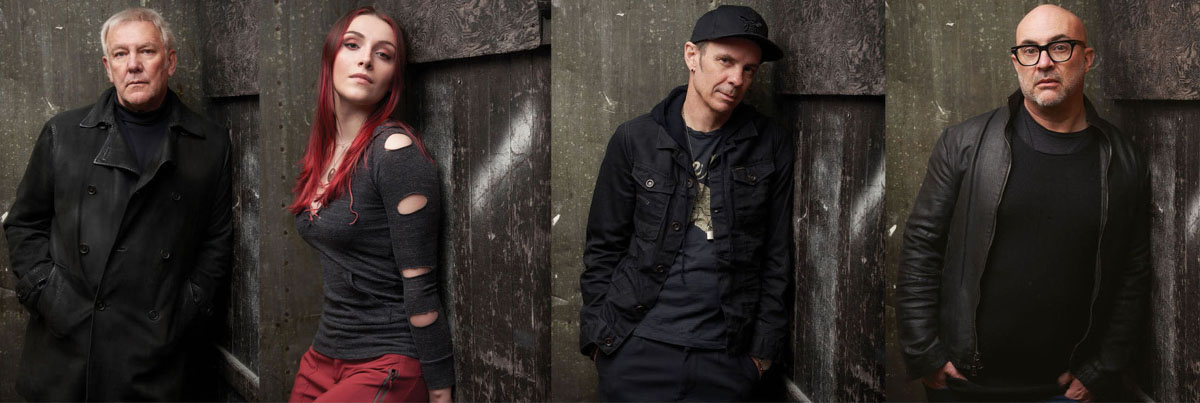
"You know, when Alex asked me to play on that song, I wasn't aware that he'd written it for Neil," chips in Curran. "And I got pretty choked-up when I did find out, so I'm glad Alex didn't tell me beforehand, otherwise I would have totally messed up."
Silent for a few seconds, each of Prog's three interviewees smiles.
"But truthfully," adds Lifeson eventually, "I had mixed feelings about having Western Sunset on there. But I think it serves a purpose. There's a lot of information to absorb on this record and we felt Western Sunset was a breather; a chance to sit back at the end and process everything."
And what of the Envy Of None record as a whole? Has a certain Mr Lee heard it?
"Geddy has heard it, yeah," says Lifeson. "I sent him a copy and he's been super, super supportive. He actually said he's proud of the way it sounds, which is great. Because of course I'd wondered if he'd be cool with it and he absolutely was."
There's been talk of Envy Of None doing some live shows, and Wynne says her mother has her heart set on them playing much-watched US chat show Jimmy Kimmel Live!. Still, all Lifeson, Wynne and Curran confirm today is that they've "talked about exploring what the album might sound like in a live setting."
So, failing a tour or some select gigs, might they make a second Envy Of None album instead? In quick succession, all three interviewees answer in the affirmative. It looks like we're through to the next round...
Envy Of None is out now via Kscope. See envyofnone.com for more information.